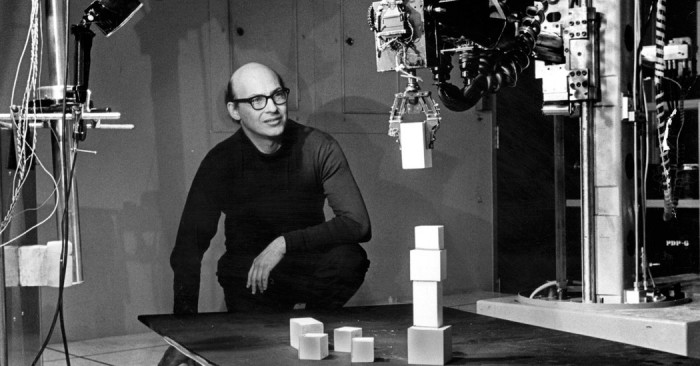Marvin Minsky, the MIT scientist, philosopher, and author, passed away last week at the age of 88, from a cerebral hemorrhage. Known around his campus as “Old Man Minsky,” he was a pioneer in a number of fields from cognitive and computer science to philosophy of mind and information theory. He is best remembered, however, for establishing the field of artificial intelligence (AI), as well as creating the MIT Artificial Intelligence Laboratory (now known as the CSAIL), which has been the driving force of AI research for decades.
During his life, Minsky also authored several books on his work such as The Emotion Machine, which extrapolates on his theories of mind and discusses the achievements and problems of AI research, Perceptrons, which deals heavily with neural network technology in relation to computer learning research, and The Society of Mind, influenced by observations from developmental psychology as applied to AI. In The Society of Mind, Minsky described how he believed intelligent robots could be designed.
“His work on the ‘reactive agent’ approach to robotic intelligence, along with his MIT colleague Rod Brooks, helped foster a different way of designing robots, especially ones that are small, autonomous, and by themselves not too intelligent,” Director of the McGill Centre for Intelligent Machines (CIM), James Clark explained.
The concept of the ‘reactive agent’ is central to the Society of Mind Theory. The theory states that intelligence and other complex phenomena scientists associate with sentient beings can emerge naturally from the interactions of several mindless 'reactive agents' operating under simple algorithms.
“Minsky showed that collections of such robots could work together to form societies which would express, in his words, ‘true intelligence,’” Clark said.
Others, however, interpreted Minsky’s career differently.
“He did quite respectable work, but I wouldn’t qualify that work as AI-related,” explained Engineering Professor Jorge Angeles, a McGill roboticist and founding father of the CIM. “My belief is that AI is a buzzword that is being exploited for commercial purposes. How can intelligence be created artificially if nobody has ever been able to define it?”
But most view Minsky’s influence as substantive and enduring. McGill computer science Professor Joelle Pineau, who teaches Artificial Intelligence (COMP 424), begins her course with a brief AI history lesson. Most importantly, she discusses the historic 1956 conference at Dartmouth that is regarded as the real beginning of AI.
“Minsky was a giant in our field,” Pineau said. “Until this week, Minsky was the last of the big names from that meeting to still be alive.”
Over the course of Minsky’s long and extraordinarily varied career outside of the lab, he also served as a scientific adviser on Hollywood sci-fi films such as 2001: A Space Odyssey, and even suggested the plot of the novel Jurassic Park to author Michael Crichton during a walk on the beach.
His more technical innovations include developing the confocal microscope (invaluable to the life sciences for its high degree of resolution), the head-mounted display (a major milestone in virtual reality), and creating in 1951 the first ever randomly-wired neural network, called SNARC.
“Although I never had the pleasure of meeting Marvin Minsky, I was certainly influenced by his research, as were countless others who work in Cognitive Science and AI,” McGill psychology Professor Thomas Shultz, who studies neural networks, said.
Minsky also collaborated with MIT Professor Seymour Papert on the first educational robots called ‘turtles,’ which used a programming language they developed called Logo. Since then, these robots have been used by a number of professionals looking to help children learn basic programming skills.
“During a sabbatical, I noticed that my daughter’s third grade class lacked an effective way to use newly supplied classroom computers,” Shultz said. “In my spare time, I designed a modest Logo course and taught it to these third graders, as a demo for the school’s teachers. It was fun to see that Papert and Minsky were correct in their prediction that kids would love doing this.”
There happens to be a significant coincidence in the timing of Minsky’s passing which corresponds to another major AI landmark.
“It seems particularly poignant that Minsky passed away the same week that we are hit with the impressive news that an AI system had reached human-level in Computer Go,” Pineau said.
Go is an ancient and very abstract board game a lot more complicated than chess. Computers have been consistently beating humans at chess for years now, but researchers thought teaching them Go would take much longer than it did.
Computer learning is advancing at breakneck speed—even if Minsky didn’t think so—and this is largely because of his work and the work of others he inspired.
“Minsky is survived by his wife Gloria Minsky; three children, Margaret Minsky, Julie Minsky, and Henry Minsky,” wrote an automated news-writing bot known as Wordsmith for Wired.
Software programs like Wordsmith aren’t exactly AI, but they show the incredible degree of sophisticated output achievable by coding and algorithms that was once thought impossible, and the modern world has Marvin Minsky to thank for that.








